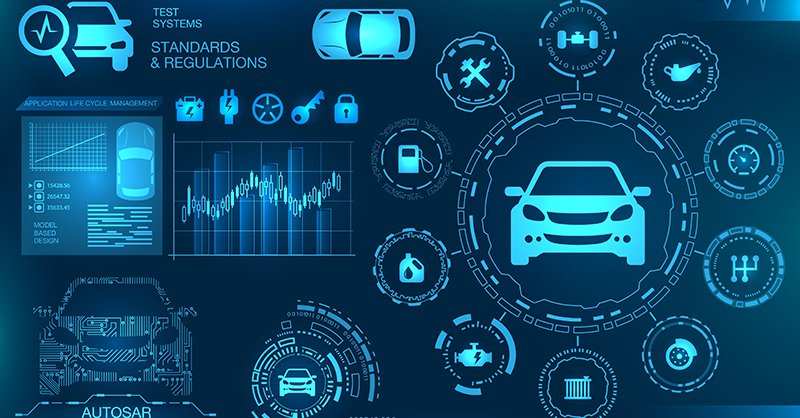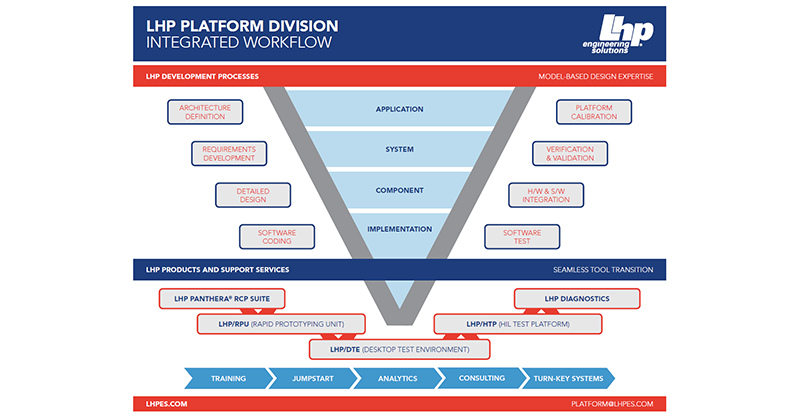LHP Reinvents the Traditional Engineering V-Model
LHP Engineering Solutions will be exhibiting at the 23rd annual NI Week in Austin, Texas, at the Downtown Convention Center, May 22- May 25. LHP is...
Unlock Engineering Insights: Explore Our Technical Articles Now!
Discover a Wealth of Knowledge – Browse Our eBooks, Whitepapers, and More!
Stay Informed and Inspired – View Our Webinars and Videos Today!
Exploring the future of software-defined vehicles through expert insights.
3 min read
 Megan Verkamp
:
Oct 19, 2015 8:33:00 PM
Megan Verkamp
:
Oct 19, 2015 8:33:00 PM

Table of Contents
LHP is releasing a new product into our model-based design and test workflow at the Automotive Testing Expo in Novi, MI on 10/20. The LHP Hardware-in-the-Loop Test Platform (LHP/HTP) supports verification and validation of embedded systems development.
This is the third blog in a three-part interview series that highlights the new LHP/HTP. Click here for part one, and here for part two.
Our final interview in the series is with Jamie Williams. Jamie is the Verification Application Consultant for LHP Engineering Solutions and a member of the Platform Group.
Jamie Williams Interview
Brianna: What is the purpose of the LHP Hardware-in-the-Loop Testing Platform (LHP/HTP) test software?
Jamie: The LHP/HTP is an integrated system for the testing of embedded-control software. Hardware-in-the-Loop (HIL) test environments provide a real-world product simulation environment that incorporates models that interact directly with the electronic control module (ECM). In the automotive world, the models simulate the engine, road conditions, transmissions, etc. HIL systems are valuable test and development environments for any industry that leverages embedded controllers such as automotive, aerospace, medical, or consumer product.
While the hardware within the test system emulates the hardware used on actual products, the software is used to provide a user-friendly turnkey approach for the purpose of verification and validation of the end product. The LHP/HTP consistently, repeatedly, and reliably provides reproducible test results within a closed-loop environment that mimics the real world in which the product will be utilized. HIL test environments can be used for early software verification by developers, but they are primarily used for product verification and validation.
Brianna: What user interface capabilities are available in the LHP/HTP system?
Jamie: LHP Engineering Solutions has designed a 3-Tier Test Environment Architecture approach to provide test solutions to our clients:
Client-selected options extend each architecture tier to further tailor the system to meet the requirements based upon blocks that each build up to the next tier. Thus, the LHP/HTP can be made extensible and grow according to client needs. LHP can provide a basic open-loop system, a closed-loop automated system, a complete data-driven total test automation system with traceability to requirements, as well as variations to those architectural tiers.
The LHP/HTP provides an interface that facilitates test automation or manual stimulus through a Graphical User Interface (GUI). Hardware interfaces for analog, digital, timing, waveform, power and other application-specific signals are also available. An Integrated Development Environment (IDE) facilitates test development, execution, reporting, and test management. LHP leverages National Instruments’ TestStand, VeriStand, and LabVIEW products to provide total test automation, in which the LHP/HTP software configures the hardware interfaces to a specific application then executes predefined test sequences.
Brianna: What special testing features and functions are available for the user?
Jamie: LHP provides a 3-Tier Test Environment Architecture to support customization to the client’s needs, with manual, automated, and database-driven capabilities. The LHP/HTP provides data-driven test automation, database-driven test environment configuration, and a GUI that facilitates manual test execution and debug capability. The LHP/HTP incorporates features such as self-diagnostics, trouble codes, communication protocols, wireless technology, and remote access, among others.
LHP/HTP implementations will vary with respect to I/O count, software functionality, and features depending on customer needs. Incorporating growth into the design will allow reuse of existing capability while facilitating extending capability with additional feature sets and support applications. The client’s test strategy can use data-driven automated tests written to verify a specific functionality, while the parameter attributes such as range, resolutions, execution rates, etc. are defined using a database. Well-designed test scripts are as important to product verification and product quality as model design is to product capability.
Brianna: Can the user modify and configure tests?
Jamie: Yes, users can modify test scripts, reuse tests from previous application, and even automate script development. An LHP/HTP system can provide total test design, development, execution, reporting, and defect management capability. The test levels supported are only limited by the client’s specifications. The LHP/HTP can incorporate database driven configuration and data-driven test capability through custom steps that facilitate ease of use, custom reporting capability, configuration management, as well as automatic regression execution. Leveraging the 3 Tier Test Environment approach, the client can start with basic functionality and extend this functionality to meet their growing and complex needs.

LHP Engineering Solutions will be exhibiting at the 23rd annual NI Week in Austin, Texas, at the Downtown Convention Center, May 22- May 25. LHP is...

NI Drivven Powertrain Modules, Exclusively sold by LHPTS, an LHP division.

Effective Test Cases and How Inputs Influence Decisions This is Part 2 in a series on creating high-quality test scripts. In “Writing High-Quality...